Float therapy has become an intriguing frontier in mind‑body wellness, where the soothing environment of a floatation session intersects with neuroscience and brainwave modulation. But what exactly is the connection between float therapy and brainwave activity? In this article, we’ll explore float therapy, what it is, the science behind float therapy, the effects of float therapy on brainwave patterns, and how those changes underlie many of the benefits of float therapy, float session benefits, and health benefits of float therapy. We’ll also look at use cases like float therapy for depression, float tank anxiety, float therapy for relaxation, and more.
Introduction to Float Therapy & Key Concepts
Float Therapy What Is It?
At its simplest, float therapy (also called floatation therapy, isolation tank therapy, or sensory deprivation float therapy) involves floating in a dark, sound‑proof tank filled with highly concentrated Epsom salt water, at skin temperature, so that your body experiences almost no tactile sensation or gravitational pressure. The goal is to shut off or greatly reduce external sensory input. This environment is sometimes called a sensory deprivation float tank or float deprivation tank.
A float therapy session typically lasts 60 to 90 minutes, though first timers may begin with shorter durations. In a float session therapy the participant enters the floatation tank, settles into silence and darkness, and allows the mind and body to rest without external interruption.
The purpose of sensory deprivation tank is to minimize sensory input (no light, no noise, little tactile stimulation), so that internal neural dynamics can come to the forefront. In isolation tank therapy, the brain is freed from processing constant external stimuli and can transition into deeper, more subtle internal states.
Brainwave Basics: A Primer
To understand the connection between float therapy and brainwave activity, it helps to know what brainwaves are. Brainwaves are electrical oscillations in the brain, typically classified by frequency bands:
- Beta waves (≈ 13–30 Hz): Associated with normal waking consciousness, active thinking, problem solving, anxiety, focus.
- Alpha waves (≈ 8–13 Hz): A relaxed but alert state, often when the eyes are closed or during quiet reflection, light meditation.
- Theta waves (≈ 4–8 Hz): Deeper states of relaxation, creativity, insight, memory, drowsiness, liminal states between wake and sleep.
- Delta waves (< 4 Hz): Deep sleep, unconsciousness, very slow restorative states.
In general, moving from beta toward alpha and theta is associated with deeper states of rest, introspection, and healing.
The Science Behind Float Therapy & How Brainwaves Are Affected
Sensory Deprivation as a Trigger
One of the central ideas in isolation tank therapy or sensory deprivation float therapy is that by dramatically reducing sensory input, the brain will reduce its “default” level of vigilance and processing. In ordinary life, the brain is constantly bombarded by visual, auditory, tactile, thermal, vestibular, and proprioceptive signals. Each of those tends to push brain activity into higher frequencies (beta). The science behind float therapy suggests that when that bombardment is removed, neural circuits will settle down, giving more room for slower oscillations like alpha and theta.
Neural Shifts: Beta → Alpha → Theta
In practice, what researchers and floaters often report is a gradual shift:
- Reduced Beta Activity
In a float therapy session, the brain no longer needs to process as much sensory information to monitor the environment. That reduces the demand on beta‑wave systems. The mind’s “chatter,” vigilance, mental stress all associated with beta start to quiet down. - Emergence of Alpha Activity
As the brain relaxes, alpha waves become more dominant. This is the hallmark of a relaxed wakeful state, eyes closed, restful, calm. Many floaters experience a sustained alpha state during much of a session. - Accessing Theta States
With further acclimation, theta can emerge. Theta is associated with deeper meditation, introspection, memory, insight. In many float sessions, theta becomes prominent sometimes within 15–30 minutes of floating. It’s in these states that many of the more subtle mental, emotional, and creative benefits manifest. - Modulation of Brain Networks
Beyond mere frequencies, float therapy may influence connectivity in networks like the Default Mode Network (DMN), reducing self‑referential rumination and internal “noise.” The quieter, more flexible brain network states may contribute to emotional regulation and mental healing.
Thus, float session therapy is not just restful; it’s a neurophysiological reset of sorts.
Effects of Float Therapy & Health Benefits of Float Therapy
Because floating shifts brainwave patterns and relaxes the body, it yields many float therapy benefits, float session benefits, and health benefits of float therapy. Below are key benefits linked to brainwave changes and other physiological effects.
1. Profound Relaxation & Stress Reduction
- Benefit: Many users report intense calm, deep rest, lower blood pressure, decreased heart rate, reduced cortisol.
- Mechanism: With reduced beta and increased alpha/theta, the parasympathetic (“rest and digest”) system becomes dominant. The brain doesn’t need to monitor external stimuli, so internal repair and recovery can accelerate.
2. Anxiety Relief (Float Tank Anxiety)
- Benefit: Reductions in state anxiety, less rumination, lower physiological tension.
- Mechanism: Floating eases overactivity in beta circuits, quiets the mind, and breaks cycles of worry. Theta and alpha states help the mind gently reframe thoughts, unstick stuck patterns.
3. Depressive Symptom Relief (Float Therapy for Depression)
- Benefit: Mood lift, reduced symptoms of depression, better resilience.
- Mechanism: By reducing the “default mode” overthinking, interrupting negative rumination, enhancing neuroplasticity via restful brain states, float therapy can assist in alleviating depressive patterns. The shift into theta/alpha states offers emotional insight and integration.
4. Better Sleep & Recovery
- Benefit: Deeper, more restorative sleep, falling asleep faster, waking refreshed.
- Mechanism: The brain’s transition through relaxed states primes it for better sleep. Also, the float deprivation tank benefits include lowering hyperarousal that often interferes with sleep.
5. Pain Relief & Physical Healing
- Benefit: Relief from chronic pain, faster recovery from injury, reduced muscle tension.
- Mechanism: The body’s release from gravity, the magnesium sulfate (Epsom salt) environment, and the calming brainwave states reduce nociceptive input, allow circulatory and repair processes to proceed, and quiet pain signals. These physical benefits reinforce the mental ones.
6. Enhanced Creativity, Insight & Clarity
- Benefit: Many floaters report bursts of creativity, clarity, problem‐solving, intuitive insight.
- Mechanism: Theta waves are associated with subconscious processing, new associations, pattern emergence. In floatation tanks, with external noise removed, the brain is freer to explore internal landscapes and associative leaps.
7. Emotional Regulation, Resilience & Neuroplastic Gains
- Benefit: Better emotional balance, reduced reactivity, more capacity to handle stress.
- Mechanism: Over repeated float therapy sessions, brain networks may rewire, shifting from rigid default activity toward more adaptable states. Repeated access to relaxed brainwave states assists emotional consolidation and regulation.
The Connection in Practice: What Happens During a Float Therapy Session
Let’s walk through a typical float therapy session and the brainwave journey inside:
- Entry & Adjustment (0–5 min)
You enter the tank, ambient calm, dim or no light. The first few minutes may feel odd or uncomfortable. Your brain is still in higher beta mode anticipating, monitoring, adjusting. - Settling In (5–15 min)
As your body relaxes, your mind loosens. Beta begins to decline, alpha begins to emerge. The external world recedes; internal awareness becomes more salient. - Alpha Phase (15–25 min)
You may settle into sustained alpha—peaceful alertness, inner quiet, gentle awareness. This is one of the float session benefits that many perceive early on. - Theta Entry (25–60+ min)
With enough time, deeper theta emerges. This is where insight, emotion, memory integration, creativity, and deeper rest dwell. For many, this is the “sweet zone” of floating. - Crossover & Emergence
Near the end, as the session closes, the brain gradually returns to more alpha or even light beta reorienting to external reality. Many floaters feel refreshed, clear, calm, energized.
This progression from beta to alpha to theta is the core connection between float therapy and brainwave activity.
Practical Tips to Leverage This Connection
- Start slow if new: Try 30–45 minute floats initially. As comfort grows, move to full 60–90 min for deeper theta access.
- Consistency helps: Repeated float sessions help the brain and body adapt more quickly into relaxed states.
- Don’t force it: The shift may not be dramatic every time. Let your brain “find” its rhythm.
- Combine with mindfulness or gentle breathwork: These practices can help escort the brain into alpha/theta more readily.
- Journal or integrate afterward: After floating, capture insights, feelings, or creative ideas that arose during theta phases.
Limitations & Considerations
- Some people may feel discomfort, claustrophobia, or restlessness early on in sensory deprivation float therapy.
- Not everyone will experience deep theta in every session; brainwave shifts depend on mental state, external stress, and individual neurobiology.
- People with certain medical or psychiatric conditions (e.g. severe anxiety, epilepsy, psychosis) should consult professionals before doing isolation tank therapy.
- Maintenance of tank hygiene and safety protocols is crucial.
- Float therapy is not a panacea but a powerful complement to psychological, medical, and holistic approaches.
Why This Connection Matters
Understanding the connection between float therapy and brainwave activity is more than academic. It gives us a map: how float therapy works at a neural level, why it feels powerful, and how to structure sessions for maximal effect. The brainwave shifts are not side effects, they are the mechanisms through which the benefits of float therapy, health benefits of float therapy, float session benefits, and mental health improvements (for depression, anxiety, stress) emerge.
Float therapy is more than relaxation; it’s a tool for rewiring one’s internal landscape, calming overloaded neural systems, and restoring balance. The purpose of sensory deprivation tank is not simply deprivation for deprivation’s sake, but creating a field within which the brain can reorganize, drift, heal, and emerge renewed.
Frequently Asked Questions (FAQ)
Q1. How strong is the scientific evidence that float therapy changes brainwave activity?
Answer: The evidence is still emerging but promising. EEG and neuroimaging studies have reported increased alpha and theta wave prevalence during floats, and alterations in brain connectivity (especially in the default mode network). However, more controlled, large‑scale trials are needed to fully map the effects.
Q2. How many float sessions are needed to observe meaningful changes?
Answer: Some people feel benefits after the first or second session—relaxation, clarity, better sleep. But for sustained brainwave reorganization and mental health benefits (e.g. for depression or chronic stress), many practitioners recommend weekly or biweekly sessions over several weeks or months.
Q3. Is float therapy safe for people with anxiety or claustrophobia?
Answer: Generally yes, for mild to moderate anxiety it is considered safe, and many use float therapy for anxiety relief. Float tank anxiety is something many floaters face initially, but adaptation often occurs. However, individuals with severe claustrophobia, panic disorder, or certain psychiatric conditions should proceed carefully and perhaps try guided or shorter sessions first.
Q4. What happens if I don’t reach “theta” state in a float session?
Answer: That’s okay. Even if a session remains in alpha-dominant states, you still receive many of the benefits of float therapy—stress reduction, relaxation, shifting away from overactive mental states. Not all sessions will reach deep theta, and that doesn’t mean the session was ineffective.
Q5. Can float therapy replace meditation or psychotherapy?
Answer: Probably not, but it can be a powerful complement. Many people find that float therapy accelerates their meditation progress or enhances therapeutic processes by allowing deeper insight and emotional access in a calm internal space.
Q6. Are there side effects or risks?
Answer: Occasionally, people report restlessness, mild anxiety, dizziness, or discomfort, especially in early sessions. Physical risks are minimal if tanks are well maintained. Those with open wounds, skin conditions, epilepsy, or severe psychiatric disorders should consult medical professionals before trying sensory deprivation float therapy.





